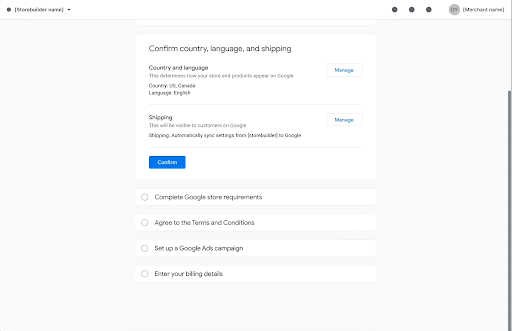關於本指南
本指南旨在提供一套整合最佳做法,讓商店建立工具的使用者能夠放送免費產品資訊和付費廣告。本指南將提供流暢的使用體驗,協助商店建設者順利啟用商家。本指南重點介紹如何有效管理大量 Merchant Center 和 Google Ads 帳戶所需的 Google API。瀏覽指南時,大部分章節都會提供下列指南:
- 簡介與業務效益
- 技術指引 (API 和其他項目)
- 包含螢幕截圖的使用者體驗指南
- 已知問題和提示
本指南的使用方式
在瀏覽這項資源的過程中,您會找到 5 個更廣泛的步驟,以建立強大的基礎整合:
- 帳戶設定
- 上傳產品
- 資料品質 / 疑難排解
- 廣告
- 通報偏誤
在以下步驟中,您都有應實作的基本功能。大部分功能為必要功能,但有些依據眾多因素而不需要。取決於您的所在地、商家指定位置、決定實作方式,以及要導入的購物計畫。
新手上路的使用者體驗設計指南
請務必建立新手上路體驗,引導商店建立工具的商家在 Google 上展示產品,並藉由避免可避免的錯誤,在一開始就奠定成功基礎。
我們建議使用者體驗統整免費產品資訊和付費廣告的新手上路規定,並視需要提供選用的付費廣告步驟,包括建立付費廣告,包括設定 Google Ads 廣告活動,以及輸入帳單詳細資料。
您在設計整合作業時,應留意下列 3 項專屬的新手上路使用者體驗原則。
輕鬆完成必要的新手上路流程
請參考下列建議,方便商家輕鬆上手:
簡化新手上路:建議僅執行最少的必要工作。
智慧型預設值一律可供編輯:設定設定時,請代表商家接受合理的猜測結果,然後公開您的選項並允許其編輯。
單頁新手上路:最佳做法是將所有新手上路工作放在單一頁面。商家在開始進行新手上路流程時,以及在新手上路流程的任何階段,都可以同時查看所有工作。
允許商家稍後再完成複雜工作:如果是網站政策檢查和運送設定,請讓商家在新手上路期間略過,稍後再完成。請參閱接著提醒並引導商家完成新手上路流程。
內容指引
我們建議引導商家瞭解新手上路工作帶來的影響,並只在與目前商家目前合作的任務相關時,顯示精簡指引。
適應性
這些規範提供了分類,且適用於各種商店建構工具。建議您根據整合情況進行調整,選取最符合其平台條件的選項。舉例來說,只有具備強大運送系統的開放式資源儲存庫建構工具和商店建構工具提供運送設定。

聯絡管道
如有任何疑問或需要支援,建議採取下列做法:
Content API for Shopping 支援團隊:如需技術支援,請與 Content API for Shopping 支援團隊聯絡。
Google Merchant 支援:這個支援管道可協助您解決 Merchant Center 和付費廣告相關問題。
Google 聯絡窗口 (POC):如果您有專屬的 Google 聯絡窗口可以支援整合,建議您直接與該業務人員聯絡,向他們尋求協助。
